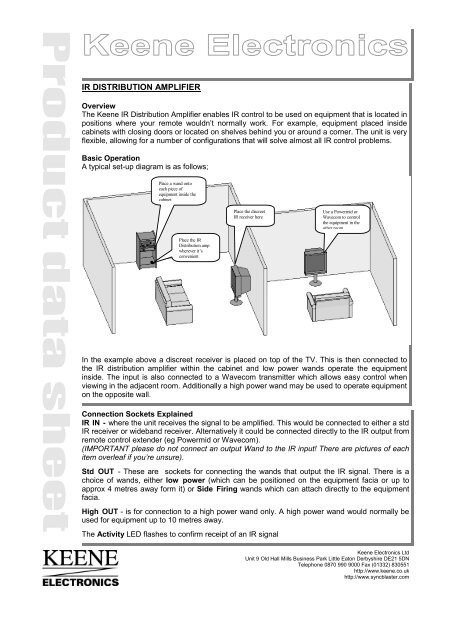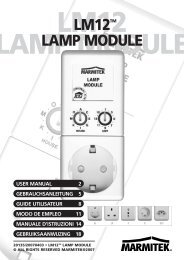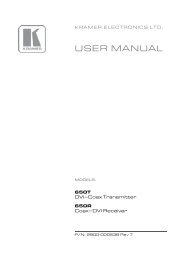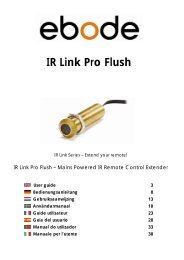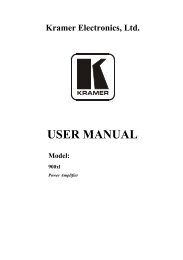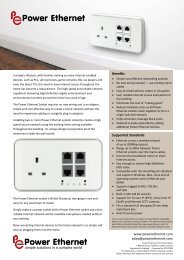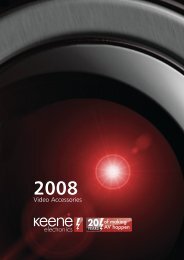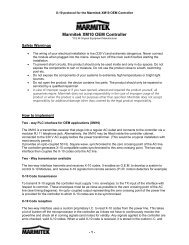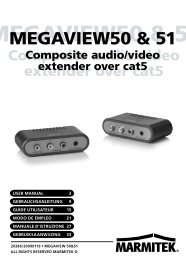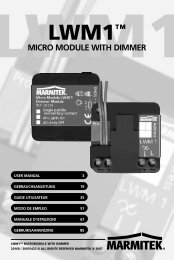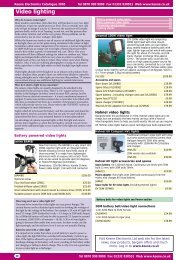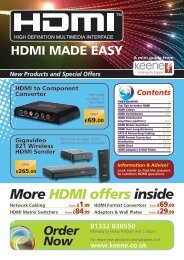IR dist amp Instructions.pub - Keene Electronics
IR dist amp Instructions.pub - Keene Electronics
IR dist amp Instructions.pub - Keene Electronics
You also want an ePaper? Increase the reach of your titles
YUMPU automatically turns print PDFs into web optimized ePapers that Google loves.
Product data sheet<br />
<strong>IR</strong> DISTRIBUTION AMPLIFIER<br />
Overview<br />
The <strong>Keene</strong> <strong>IR</strong> Distribution Amplifier enables <strong>IR</strong> control to be used on equipment that is located in<br />
positions where your remote wouldn’t normally work. For ex<strong>amp</strong>le, equipment placed inside<br />
cabinets with closing doors or located on shelves behind you or around a corner. The unit is very<br />
flexible, allowing for a number of configurations that will solve almost all <strong>IR</strong> control problems.<br />
Basic Operation<br />
A typical set-up diagram is as follows;<br />
Place a wand onto<br />
each piece of<br />
equipment inside the<br />
cabinet<br />
Place the <strong>IR</strong><br />
Distribution <strong>amp</strong><br />
wherever it’s<br />
convenient<br />
Place the discreet<br />
<strong>IR</strong> receiver here<br />
Use a Powermid or<br />
Wavecom to control<br />
the equipment in the<br />
other room<br />
In the ex<strong>amp</strong>le above a discreet receiver is placed on top of the TV. This is then connected to<br />
the <strong>IR</strong> <strong>dist</strong>ribution <strong>amp</strong>lifier within the cabinet and low power wands operate the equipment<br />
inside. The input is also connected to a Wavecom transmitter which allows easy control when<br />
viewing in the adjacent room. Additionally a high power wand may be used to operate equipment<br />
on the opposite wall.<br />
Connection Sockets Explained<br />
<strong>IR</strong> IN - where the unit receives the signal to be <strong>amp</strong>lified. This would be connected to either a std<br />
<strong>IR</strong> receiver or wideband receiver. Alternatively it could be connected directly to the <strong>IR</strong> output from<br />
remote control extender (eg Powermid or Wavecom).<br />
(IMPORTANT please do not connect an output Wand to the <strong>IR</strong> input! There are pictures of each<br />
item overleaf if you’re unsure).<br />
Std OUT - These are sockets for connecting the wands that output the <strong>IR</strong> signal. There is a<br />
choice of wands, either low power (which can be positioned on the equipment facia or up to<br />
approx 4 metres away form it) or Side Firing wands which can attach directly to the equipment<br />
facia.<br />
High OUT - is for connection to a high power wand only. A high power wand would normally be<br />
used for equipment up to 10 metres away.<br />
The Activity LED flashes to confirm receipt of an <strong>IR</strong> signal<br />
<strong>Keene</strong> <strong>Electronics</strong> Ltd<br />
Unit 9 Old Hall Mills Business Park Little Eaton Derbyshire DE21 5DN<br />
Telephone 0870 990 9000 Fax (01332) 830551<br />
http://www.keene.co.uk<br />
http://www.syncblaster.com
Hints and tips for using the <strong>IR</strong> Distribution <strong>amp</strong>lifier<br />
1/ The high power wand will work in either the high power or the standard power sockets, but the standard<br />
power emitters will operate in the std sockets ONLY. The standard socket is wired anode to the tip of the 3.5mm<br />
plug and cathode to the barrel while the high power socket is wired anode to the ring on the 3.5mm plug and<br />
cathode to the barrel.<br />
2/ If wiring up your own extension for the emitters always make all three connections so it will work with either<br />
the std or the high power emitters<br />
3/ It is permissible to use more than one <strong>IR</strong> receiver into the <strong>dist</strong>ribution <strong>amp</strong>, but only one can be receiving a<br />
signal at anyone time, otherwise the signals will mix and confuse the unit that you are trying to control. IE you<br />
can’t put a wide band and a standard receiver next to each other and feed both to the <strong>dist</strong>ribution <strong>amp</strong> as you<br />
will get a garbled result.<br />
4/ It is also possible to confuse the <strong>IR</strong> receiver on the equipment you want to control by having 2 sources of <strong>IR</strong>.<br />
for ex<strong>amp</strong>le having a standard emitter on the front of a VCR and a high power emitter pointed at the same VCR<br />
would result in 2 conflicting signals at the VCR and could result in mis-operation.<br />
5/ All the emitter diodes are directional (rather like a narrow torch beam) and this should be borne in mind when<br />
positioning the emitters. The standard ones are designed to be fitted onto say a VCR just to one side of the <strong>IR</strong><br />
receiver. The diode pointing at the <strong>IR</strong> receiver. (This is why the diode is directed at about 30 degrees<br />
downwards) The high power emitters can be positioned up to 10 meters away from the device to be controlled<br />
and must be pointed directly at it. The standard emitters can be used in some circumstances at up to about 4<br />
meters away BUT the diode must point at whatever you want to control – note that it is normally angled down at<br />
about 30 degrees<br />
6/ Take care when positioning the receiver. The wideband receiver can be affected by <strong>IR</strong> interference from TV<br />
scan coils, fluorescent lights and direct sunlight . Any interference will be noticeable because the <strong>IR</strong> <strong>dist</strong>ribution<br />
<strong>amp</strong> light will be flickering. Because of the effects of filtering a wider bandwidth results in a poorer sensitivity.<br />
This means that the Standard receiver has limited bandwidth but a very good range (<strong>dist</strong>ance) and conversely<br />
the wide band receiver has a good bandwidth but poorer range. In general the standard receiver will give the<br />
best performance and the wide band should only be used if you have equipment that doesn’t operate in the<br />
40Khz band.<br />
7/ The Powermid is an ex<strong>amp</strong>le of a wide band receiver.<br />
8/ Whilst a splitter (KA109) may be used on the input it should never be used on a wand output.<br />
Code Description Price*<br />
<strong>IR</strong>BKIT<br />
Basic <strong>IR</strong> Distribution Amp kit containing 1 high power wand, 1 low power wand, Distribution <strong>amp</strong><br />
and power supply<br />
<strong>IR</strong>LPW Low power wand £5.99<br />
<strong>IR</strong>HPW High power wand £7.99<br />
<strong>IR</strong>SR Standard receiver for most domestic equipment (40KHz) £7.99<br />
£34.99<br />
<strong>IR</strong>WBR Wideband <strong>IR</strong> receiver for equipment up to 100KHz £12.99<br />
KLDE6<br />
KLDE10<br />
Couples the Powermid <strong>IR</strong> output directly to the <strong>IR</strong> <strong>dist</strong>ribution <strong>amp</strong> input (3.5mm jack to 3.5mm<br />
jack)<br />
Couples the Wavecom <strong>IR</strong> output directly to the <strong>IR</strong> <strong>dist</strong>ribution <strong>amp</strong> input (2.5mm jack to 3.5mm<br />
jack)<br />
KLD40 3 metre extension lead for input or output £4.49<br />
KLD405 5 metre extension lead for input or output £4.99<br />
KLD4010 10 metre extension lead for input or output £8.99<br />
KA109<br />
<strong>IR</strong> input splitter 1 x 3.5mm jack to 2 x 3.5mm sockets for using both cabled feed (Powermid/<br />
Wavecom) and in-room <strong>IR</strong> receiver)<br />
*prices correct at time of printing and may be subject to change<br />
£5.99<br />
£8.99<br />
£1.89<br />
<strong>IR</strong>LPW <strong>IR</strong>HPW <strong>IR</strong>SFW <strong>IR</strong>SR <strong>IR</strong>WBR


